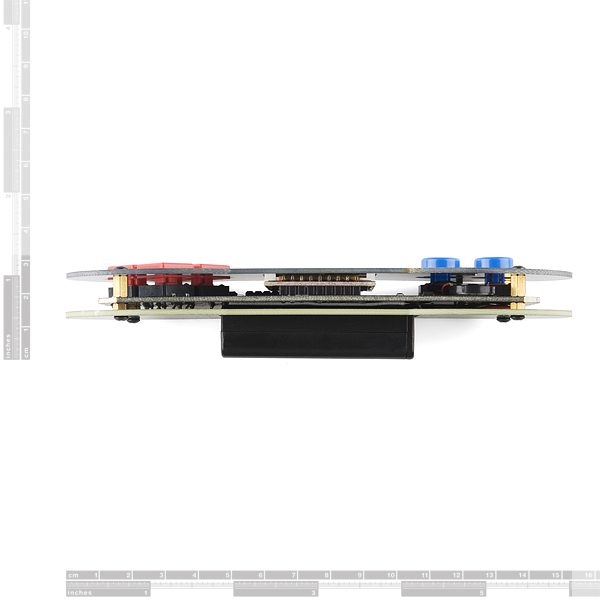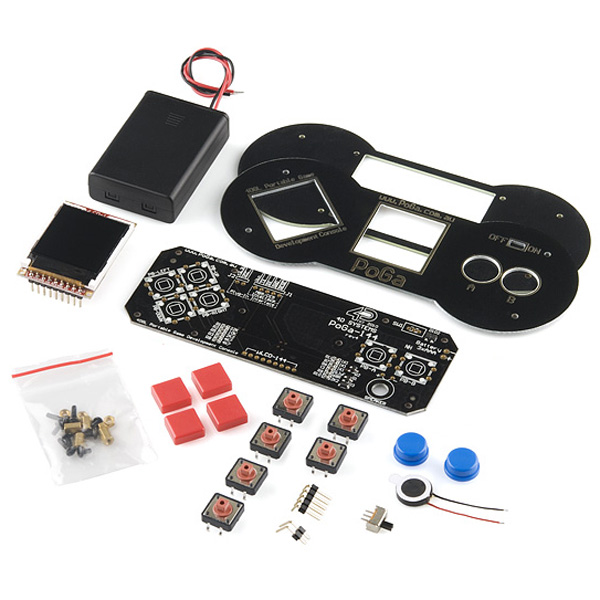PoGa - Portable Game Development Console Kit
Replacement: None. We are no longer carrying this development kit, but check out our development tools category! This page is for reference only.
The PoGa kit is a Portable Game Development console that uses 4D Systems' Graphic Language (4DGL). The PoGa incorporates a 128xRGBx128 pixel full color TFT display, 'standard' game console push button layout for controlling the game flow, a small loudspeaker for sound effects, and a micro SD card for storing images and game data. It is driven by the tiny yet powerful GOLDELOX-PoGa custom graphics processor from 4D Labs. Graphics, text, image, animation and countless more features are built right inside the chip. For portability the PoGa can be powered for many hours on standard 3xAAA batteries.
The 4D Graphics language provides enough power and flexibility to make some really cool games and learn the 'art of programming' with a leisurely learning curve. The 4D Workshop incorporates a text editor, graphics tools, compiler and program down-loader in a neat and easy to use package. You can have your first demo game running within minutes and then start to understand how to modify and improve existing games or use 'building blocks' of code to create your very own games!
Note: These have a MicroSD card slot, but do not come with cards. They also do not come with batteries, but take standard AAAs. See the related items below.
- Single chip, low cost educational game development platform, incorporating the tiny GOLDELOX-PoGa graphics processor chip.
- Comes in an easy to build kit form with very low parts count and cost: GOLDELOX-PoGa chip, 6 buttons, Color LCD-TFT, Battery Holder and few discrete components.
- Display: 1.44", 128xRGBx128 resolution, 65K color TFT-LCD (directly interfaced to the GOLDELOX-PoGa chip).
- Colors: 65K simultaneous colors.
- MicroSD Card Interface: Supports the PoGa-Disk which can store and load up to 512 games and other applications as well as images and video clips. It can also be used as a storage medium for data logging applications during run time.
- Sound Support: Single channel sound engine with extended RTTTL format and allows complex generation of game sounds.
- Console: Layout fashion follows most standard game consoles with 6 buttons for game and non game related application control.
- Expandable: Power and UART lines are available via 8pin expansion port.
- Battery: Supports 3 x AAA batteries for mobility (high capacity alkaline or lithium recommended).
- Supports the high level 4DGL language platform, syntax very similar to C.
- Software Tools: Free fully integrated 4D Workshop3 IDE software development tool suite.
Comments
Looking for answers to technical questions?
We welcome your comments and suggestions below. However, if you are looking for solutions to technical questions please see our Technical Assistance page.
Customer Reviews
No reviews yet.






just got it in the mail, all put together...
oddly it did not contain the uUSB -> MB5 module. I will have to create my own now, which is not too bad, but it would be nice if everything in the kit was...in the kit.
To buy one separately is not cheap.
Have you contacted 4D Systems yet?
Email: support@4dsystems.com.au
shot an email over to sparkfun CS.
I must say this, I have NEVER been treated so well by Customer Service...EVER!
They shipped out the part that was missing from the kit and treated me very well throughout the entire process. WHich is why i will dump so much of my hard earned money into this website :)
I have no feelings one way or the other towards the product, but I want to know what the hell these graphics chips are running on. It doesn't look quite like an FPGA... is it a fast microcontroller? Does this company have custom silicon? What he heck is going on here? Why do these companies feel the need to obscure what's ACTUALLY going on...
I spoke to the company about this... here is what they said:
"
All our processors use a soft core, called E.V.E (Extensible Virtual Engine).
Different chips have different resources, but basically the EVE is the same in all of them. We went the soft core way so that any enhancements (or bug fixes) can be easily updated by the user via PmmC file programming, think of the PmmC file as the soft silicon.
We have a solid chip like the goldelox and the picaso (with different resouces such as amount of RAM, FLASH, Hardware peripherals, etc) and we embed our soft care virtual processor on top of it. What we also do is embed (inside the PmmC) all the library functions that each chip uses (EVE is the same in all but depending on the resources of the base chip the amount internal functions we can fit varies).
"
I am no EE but all I can say as of now is that I like the device and that it runs really good. They have those built in functions, those don't take code space away from you. So when I had to draw a circle I just called the method. In other devices you would need to make your own method for those things. You can check the PDFs on their website... it explains a lot of things, and also shows the internal functions.
On a less informational note. I am still in high school, and my friends picked the PoGa up and played the game I am working on. They have iPods and all, but they're amazed that I made the game, and they liked the retro feel it has. They put it down right as class started. I just like show my friends my creations :)
Sorry for the super long comment ;) I hope it helped.
I'll just but this for the display and the USb converter. Buying those separately will cost you $57,90 vs. $49.95 that this kit costs.
I made my first project...
http://www.youtube.com/watch?v=3z0i7AyidKU
It was easy to program that game and the device has great potential.
Code is here: http://4d.websitetoolbox.com/post?id=5067160&pid=1267037587#post1267037587
Wow, great code oz-solutions.
It's commented very well.
That's just what I was looking for.
keep up the good work.
I would love love love a more open version of this kind of thing. Like a Meggy Jr. (AVR powered) but with that kickass screen instead of the 8x8 matrix.
Don't get me wrong, I like 4D Systems' stuff (I liked their SOMO audio module, super easy to use) but being proprietary it's pretty difficult to exceed the original design.
that was my initial thought, but...
4DGL is pretty amazing, In my comment below you can see that I got a game made in a fairly short amount of time (about 8 hours).
"but being proprietary it's pretty difficult to exceed the original design." - In my opinion there is no way to exceed a custom made graphics chip with internal functions that make this thing run lighting fast.
I've done drawing on screen, with a regular micro controller and the time it took for it to get drawn killed my inner child >.<
I'm sure the Meggy is nice, but when you add that "kick ass" screen, a micro controller won't do it justice.
Watch my video and check out the code, also the PoGa has a UART at the top that can be used to communicate with a micro controller like an Arduino, or netduino.
Meh. Calling the picaso chipsets 1,000 polygons a second wicked fast is a strech and the picaso is a lot morepowerful than the anemic goldelox, only the low resolution saves you from long and horrifying death from starvation while waiting for your graphics to draw.
What 4DSystems does well is price their products at a good value for your money, since anything faster is way more expensive, and anything cheaper is hard to use, requires poorly document functions, or doesn't even have a processor at all. The 4DGL is a decent language but the processor designs have very little free ram, making any complex graphics too slow if not out of the question all together. For programmers who are used to manipulating memory buffers and then drawing, forget it. There is one buffer, the screen. I am a fan of 4Dsystems for MCU displays. Just plan your projects out well in advance, order from OZ, it will cost you int. Fedex, and they will screw the dingo three times before they get the order right.
There is some official videos on youtube of that thing in action.
http://www.youtube.com/watch?v=3kNpROpava4
Oh my goodness, I want one so bad...